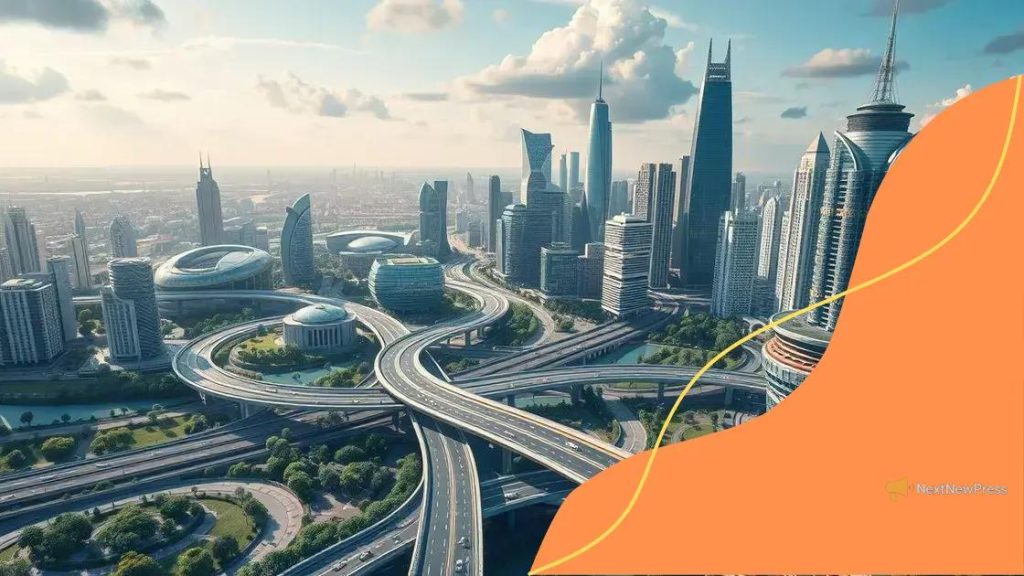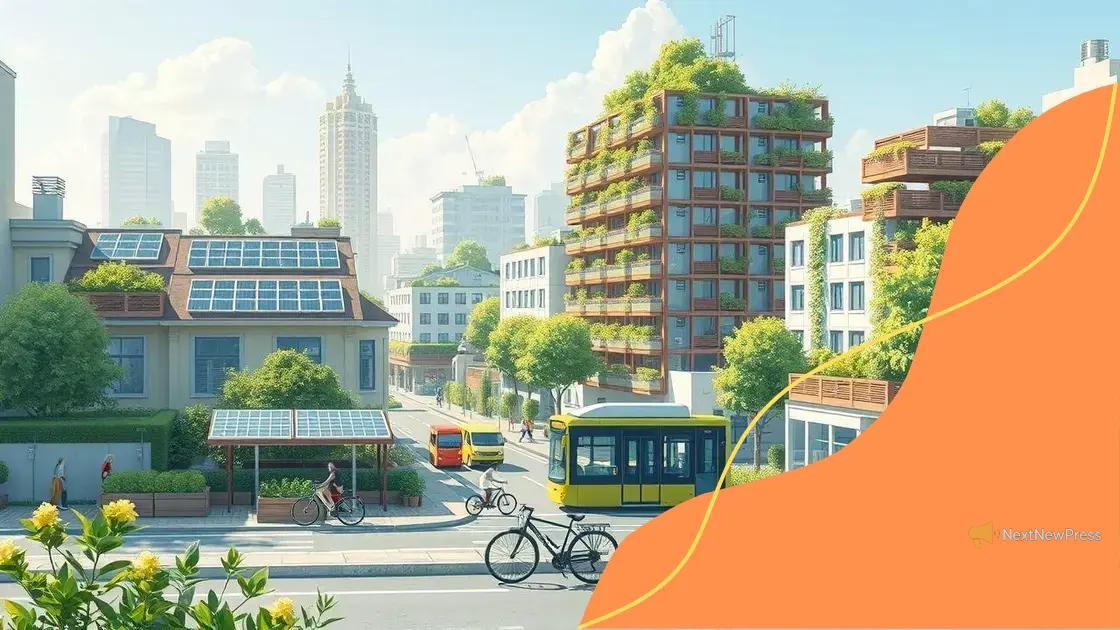The future of urban planning and smart cities

The future of urban planning and smart cities focuses on leveraging technology and community engagement to create sustainable, efficient, and livable urban environments that address challenges such as population growth and environmental sustainability.
The future of urban planning and smart cities is not just a trend; it’s a transformative movement. Imagine living in a city that adapts to your needs, thanks to data and technology. How could this change your daily life?
Understanding smart cities and their significance
Understanding smart cities involves more than just technology; it signifies a new way of living. These cities utilize innovative systems to enhance urban life. By merging digital communication with urban planning, smart cities can provide solutions to many daily challenges.
In these environments, technology plays an essential role. For example, cities use data analytics to improve traffic management, energy consumption, and public safety. As a result, residents can enjoy a better quality of life with reduced congestion and cleaner air.
Key Features of Smart Cities
Several components make up a smart city:
- Connected infrastructure: This includes smart lighting and traffic signals.
- Data-driven solutions: Collecting data to optimize services.
- Citizen engagement: Involving residents in decisions related to urban developments.
- Sustainability: Focusing on green technologies and renewable energy sources.
With the rise of technology, communities are becoming more integrated. For instance, residents can share resources, exchange information, and easily report issues to local authorities. Such systems help in building a strong sense of community and enhance public participation.
The significance of smart cities lies in their ability to adapt and respond to the needs of their citizens. As these cities evolve, they can improve resilience against climate impacts and promote sustainability. Ultimately, this leads to healthier, happier urban living.
Innovative technologies driving urban planning
Innovative technologies are at the forefront of transforming urban planning. These advancements not only enhance the efficiency of city management but also improve the quality of life for residents. By utilizing technology, planners can create smarter and more sustainable environments.
Data analytics is one such innovation changing the landscape of urban planning. It helps in understanding population trends, traffic patterns, and resource usage. With this information, cities can make informed decisions that benefit their communities.
Key Technologies in Urban Planning
Several technologies are making a significant impact:
- Geographic Information Systems (GIS): This technology helps in mapping and analyzing spatial data.
- Building Information Modeling (BIM): It allows for detailed digital representations of buildings and infrastructure.
- Internet of Things (IoT): Connected devices provide real-time data that enhances city services.
- Smart Sensors: These devices monitor air quality, noise levels, and traffic flow, enabling better urban management.
Moreover, simulation tools allow urban planners to visualize the future of cities. By creating digital models, they can test various scenarios and anticipate outcomes. This makes urban environments more adaptable to change, such as population growth or climate issues.
Innovative technologies also promote community engagement. Online platforms allow residents to voice their opinions on proposed developments. This involvement ensures that urban planning reflects the needs and desires of the community.
As cities face pressing challenges, these tools and technologies pave the way for smarter solutions. By embracing innovation, urban planners can design more livable and resilient cities for future generations.
The role of sustainability in future cities

The role of sustainability in future cities is crucial for creating livable urban environments. Sustainable practices aim to balance the needs of the population with the health of the planet. This means using resources efficiently while minimizing waste and pollution.
Cities can implement various sustainability initiatives. For example, by promoting renewable energy sources, such as solar and wind power, urban areas can reduce their carbon footprint. Incorporating green spaces is another effective strategy. Parks and gardens not only enhance the beauty of a city but also improve air quality and provide habitats for wildlife.
Key Sustainable Practices
The following practices are essential for future cities:
- Waste management: Employing recycling programs and composting to minimize waste.
- Water conservation: Using rainwater harvesting and efficient irrigation techniques.
- Sustainable transportation: Promoting public transit, cycling, and walking to reduce vehicle emissions.
- Energy efficiency: Upgrading buildings with better insulation and energy-efficient appliances.
Future cities must also focus on creating sustainable architecture. This includes designing buildings that use fewer resources and are more energy-efficient. Integrating natural elements into architecture, like green roofs, can keep buildings cooler and improve city aesthetics.
Community participation plays a key role in advancing sustainability efforts. Engaging residents in sustainability initiatives encourages ownership and accountability. When people understand the importance of their actions, they are more likely to adopt eco-friendly practices.
Community involvement in city development
Community involvement in city development is essential for creating spaces that reflect the needs and desires of residents. When people feel connected to their neighborhoods, they are more likely to engage in initiatives that improve their community.
One effective way to boost community participation is through public meetings and forums. These events give residents a platform to voice their opinions and share ideas. Engaging citizens in the planning process helps ensure that developments meet local needs. This collaboration can lead to a more inclusive and vibrant urban environment.
Methods to Enhance Community Involvement
Several strategies can increase community engagement:
- Surveys and polls: Tools to gather feedback on community projects.
- Workshops: Hands-on sessions where residents can brainstorm solutions.
- Online platforms: Websites and apps where citizens can discuss ideas and vote on issues.
- Community events: Festivals and gatherings that foster relationships among neighbors.
Additionally, local governments can partner with community organizations to promote outreach. By working with schools, nonprofits, and businesses, they can create a network of support. This helps to spread awareness about upcoming projects and encourages participation.
Successful city development recognizes the importance of all voices in the community. When residents contribute to the planning process, cities not only become more tailored to the population but also foster a sense of pride and ownership. A city that values its citizens is more likely to thrive.
Challenges and solutions in urban planning
Challenges and solutions in urban planning are critical areas to address as cities grow and evolve. Urban planners face various obstacles, including limited resources, environmental concerns, and the need for community engagement. Identifying these challenges allows for creative solutions that enhance urban living.
One significant challenge is managing rapid population growth. Cities often struggle to provide adequate housing and services. To combat this, planners can adopt smart growth strategies. These strategies focus on developing land efficiently to reduce sprawl and increase access to public transport.
Common Urban Planning Challenges
Here are some prominent challenges faced in urban planning:
- Traffic congestion: Overcrowded roads lead to delays and pollution.
- Affordable housing: The demand for low-cost housing often exceeds supply.
- Environmental sustainability: Balancing development with green space is crucial.
- Infrastructure maintenance: Aging roads and public facilities require ongoing attention.
Some cities have found success by implementing technology-driven solutions. For example, traffic management systems use real-time data to optimize traffic flow. Similarly, community engagement tools, such as online platforms for feedback, help ensure that residents have a voice in local developments.
Moreover, sustainable practices can address environmental concerns. Incorporating green building techniques and renewable energy sources can lead to more resilient urban environments. When cities focus on sustainability, they not only improve the quality of life but also protect natural resources for future generations.
Ultimately, addressing challenges requires collaboration among city officials, community members, and experts. By working together, solutions can emerge that create thriving, sustainable urban spaces.
FAQ – Frequently Asked Questions about Urban Planning and Smart Cities
What are smart cities?
Smart cities use technology and data to improve urban living, enhancing services like transportation, energy, and public safety.
How can community engagement impact urban development?
Community engagement ensures that city planning reflects the needs of residents, fostering inclusivity and satisfaction in urban environments.
What are the main challenges in urban planning?
Challenges include managing population growth, traffic congestion, environmental sustainability, and providing affordable housing.
What role does sustainability play in urban planning?
Sustainability is vital for developing cities that prioritize green practices, reducing ecological footprints while improving quality of life.





